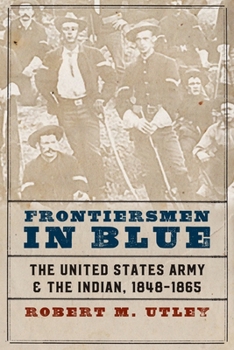Frontiersmen in Blue: The United States Army and the Indian, 1848-1865
(Part of the The Macmillan Wars of the United States Series and Macmillan Wars of the United States Series)
Select Format
Select Condition 
Book Overview
Frontiersmen in Blue is a comprehensive history of the achievements and failures of the United States Regular and Volunteer Armies that confronted the Indian tribes of the West in the two decades between the Mexican War and the close of the Civil War. Between 1848 and 1865 the men in blue fought nearly all of the western tribes. Robert Utley describes many of these skirmishes in consummate detail, including descriptions of garrison life that...
Format:Paperback
Language:English
ISBN:B004LCX6TK
ISBN13:9780803295506
Release Date:June 1981
Publisher:Bison Books
Length:438 Pages
Weight:0.60 lbs.
Dimensions:0.9" x 6.0" x 9.0"
Customer Reviews
2 ratings
Early Indian Wars
Published by Thriftbooks.com User , 21 years ago
Most people only know about the Indian Wars in the Northern Great Plains from 1866 to 1890. This book has a short history of the years 1848 to 1865 to fill the gaps in your knowledge. These years marked the continental dimensions of the United States, and the evolving policies towards the Native Americans. The military met hostile conditions of climate and geography unlike east of the Mississippi. Chapter One begins at the end of the Mexican War; an army of 100,000 officers and men invaded a foreign country and defeated forces five times their number. The Army's priority was still on westward expansion: travel routes and settlements. Mineral wealth (gold, silver) was the most important; agriculture followed later. A standing army distasteful to the Founding Fathers became a necessity in expanding the American Republic into a Continental power. While the Militia was useful, only the Regular Army could be supported by national tax dollars.The many Indian tribes were never united, and often fought among themselves as with the white settlers. The Army had to protect settlers and peaceful Indians from hostile Indians, and peaceful Indians from white settlers. The Indians knew how to live in these lands, and to take advantage of the environment. Most were partially or wholly nomadic. Their culture centered on war and its rewards. Their loose social organization exalted the individual at the expense of the group; no chief's word could bind his people. This caused conflict with the whites who could not understand this way of life. They would never attack unless they could win, and otherwise quickly disappeared from the enemy. The Army could win by operating as a disciplined team against fragmented warriors (seeking individual combat as in Medieval times). The Army also had howitzers ("guns that shot twice"), and rifles that could reach their enemy before threatened by smooth bore muskets. The Indian tribes could not unite for a vigorous and sustained offense or defense.Chapter Ten tells how the Army was organized in the Civil War. The Volunteers were the great citizen armies that bore the brunt of the fighting. They were organized by state governors and mustered into US service for 6 to 24 months. Their officers were appointed by governors, general officers by the President. The Militia were also organized by the Governors, but could not serve outside of their state or territory. The Regular Army was enlarged for the war. Most recruits chose the Volunteers for their enlistment bounties and shorter terms of service. Many of the Volunteers were used for the Indian wars, including "Galvanized Yankees" (Confederate prisoners released for this duty). Their job was to protect the wagon trains on the trails, the stations, and the telegraph lines. They provided business for contractors and neighboring towns.Chapter Sixteen provides a summary of the preceding chapters. One development was the winter campaign. A stationary tribe would be attacked, their food and l
Amazing Undertaking
Published by Thriftbooks.com User , 21 years ago
In this book Robert Utley describes in significant detail the operations of the United States and Volunteer Armies in the American West. Until this book I never quite grasped the magnitude of the problem involved, the competing vested interests, the vast distances covered and the logistical nightmares the Army faced.Detailing the regional conflicts sequentially, Utley delivers a complete analysis of the battles, campaigns and treaties involved in conquering of the American West. I never realized how many battles, skirmishes and firefights were fought. I never realized how complex the politics surrounding the Army's operations were. And most of all I never realized how limited the Army's resources of men and material were. It is truly stupefying what was accomplished in the seventeen years, 1848 - 1865, between the end of the War with Mexico and the close of the U.S. Civil War. With few exceptions all the tribes of the Pacific and those of the Great Basin were subjugated. At the same time, the foundations for the subsequent conquering of the tribes of the Great Plains, Texas and American Southwest were formulated.The final act of Manifest Destiny was the subjugation of the Native Americans. This is the story of how that process was begun.





